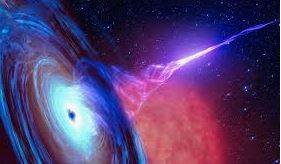 A neutron star is the collapsed core of a giant star which before collapse had a total mass of between 10 and 29 solar masses. Neutron stars are the smallest and densest stars. Neutron stars have a radius on the order of 10 kilometres (6.2 mi) and a mass of about 1.4 solar masses. hey result from the supernova explosion of a massive star, combined with gravitational collapse, that compresses the core past white dwarf star density to that of atomic nuclei.
A neutron star is the collapsed core of a giant star which before collapse had a total mass of between 10 and 29 solar masses. Neutron stars are the smallest and densest stars. Neutron stars have a radius on the order of 10 kilometres (6.2 mi) and a mass of about 1.4 solar masses. hey result from the supernova explosion of a massive star, combined with gravitational collapse, that compresses the core past white dwarf star density to that of atomic nuclei.
Once formed, they no longer actively generate heat, and cool over time; however, they may still evolve further through collision or accretion. Neutron stars that can be observed are very hot and typically have a surface temperature of around 600000 K. They are so dense that a normal-sized matchbox containing neutron-star material would have a weight of approximately 3 billion tonnes, the same weight as a 0.5 cubic kilometre chunk of the Earth (a cube with edges of about 800 metres) from Earth’s surface. Their magnetic fields are between 108 and 1015 (100 million to 1 quadrillion) times stronger than Earth’s magnetic field. The gravitational field at the neutron star’s surface is about 2×1011 (200 billion) times that of Earth’s gravitational field.
As the star’s core collapses, its rotation rate increases as a result of conservation of angular momentum, hence newly formed neutron stars rotate at up to several hundred times per second. Some neutron stars emit beams of electromagnetic radiation that make them detectable as pulsars. Indeed, the discovery of pulsars by Jocelyn Bell Burnell and Antony Hewish in 1967 was the first observational suggestion that neutron stars exist. The radiation from pulsars is thought to be primarily emitted from regions near their magnetic poles. If the magnetic poles do not coincide with the rotational axis of the neutron star, the emission beam will sweep the sky, and when seen from a distance, if the observer is somewhere in the path of the beam, it will appear as pulses of radiation coming from a fixed point in space (the so-called “lighthouse effect”). The fastest-spinning neutron star known is PSR J1748-2446ad, rotating at a rate of 716 times a second or 43,000 revolutions per minute, giving a linear speed at the surface on the order of 0.24 c (i.e. nearly a quarter the speed of light).
There are thought to be around 100 million neutron stars in the Milky Way, Some are slow-rotating and non-accreting neutron stars are almost undetectable.

